
A BROADER HISTORY OF THE DURHAM AND SUNDERLAND RAILWAY (INCLUDING MURTON STATION NOTES)
Some confusion exists over the dates of opening to traffic of the Durham & Sunderland Railway and this paragraph is a summary of what is known or at least has been reported. The Sunderland (Town Moor) - Sherburn line along with the Haswell Branch gained Royal Assent, in other words was authorised, on 13 August 1834, which allowed construction to commence. It appears the railway opened on 5 July 1836 but only to coal traffic with passenger services commencing, by means of purpose built carriages attached to the rear of coal trains, sometime during April 1837. Hetton le Hole and Pittington stations did, however, not open to passengers until 6 November 1837. This suggests passenger trains between April and November 1837 stopped between Murton and Sherburn only to change between ropes at the various winding engines along the line. The line between Sunderland and Haswell opened on 30 August 1836 but only for coal traffic. The initial, interim, passenger service ran only between Town Moor and Ryhope, which latter station opened on 19 October 1836, and from the aforementioned obscure date in April 1837 through to Haswell where passengers could change stations to reach Hartlepool.
The first line to Durham came from the east when the Durham & Sunderland Railway opened their line from Sunderland Town Moor to Pittington in 1836. The line reached Sherburn in 1837 and its terminus on 28th June 1839. However the station was not actually in Durham but at Shincliffe, south of the city. Initially the line was rope hauled; this lasted for over 20 years before locomotives were introduced. Early steam locomotives, although a marvel at the time, were incapable of managing anymore than a few horsepower if, that is, their designers could get them to work at all. The problem was well illustrated by the locomotive "Invicta" which proved incapable of managing to run the full length of the Canterbury & Whitstable Railway, Kent, due to gradients which modern trains wouldn't even notice.
The engineer for the Durham & Sunderland was a Mr Blenkinsopp (with double 'p'). In the early nineteenth century the 'Blenkinsopp' and 'Blenkinsop' spellings appear to have been used indiscriminately whereas today they are distinct. Nevertheless Mr Blenkinsopp of the Durham & Sunderland was a different person to John Blenkinsop of rack locomotive fame who in any case had died in 1831 before the Durham & Sunderland was built.
 In 1846 the Durham & Sunderland Railway was purchased by the Newcastle & Darlington Junction railway who obtained an Act for line from north of Sherburn to Shincliffe and on to Bishop Auckland. There was to be a triangular junction for access to Durham Elvet station but the line was never built. In 1846 the N & DJR was renamed the York & Newcastle Railway and the following year it amalgamated with the York, Newcastle & Berwick Railway which itself merged with other lines to form the North Eastern Railway in 1854. In 1893 the North Eastern Railway opened a station in Elvet in Durham city. This was served by a new line branching off the old Shincliffe line at Sherburn. From the 24th July 1893 the service to Shincliffe was withdrawn and the station closed. At the same time Sherburn House Station was re-sited from the junction onto the new branch. Although Shincliffe was, until Durham Elvet was built, supposedly the station for Durham, contemporary timetables name Sherburn as the station for Durham with a connecting omnibus service. Sherburn station can be a source of confusion; the 1837 station was named simply "Sherburn" and was renamed to "Sherburn House" in 1874 with this name transferring to the second, 1893, station. In 1846 the Durham & Sunderland Railway was purchased by the Newcastle & Darlington Junction railway who obtained an Act for line from north of Sherburn to Shincliffe and on to Bishop Auckland. There was to be a triangular junction for access to Durham Elvet station but the line was never built. In 1846 the N & DJR was renamed the York & Newcastle Railway and the following year it amalgamated with the York, Newcastle & Berwick Railway which itself merged with other lines to form the North Eastern Railway in 1854. In 1893 the North Eastern Railway opened a station in Elvet in Durham city. This was served by a new line branching off the old Shincliffe line at Sherburn. From the 24th July 1893 the service to Shincliffe was withdrawn and the station closed. At the same time Sherburn House Station was re-sited from the junction onto the new branch. Although Shincliffe was, until Durham Elvet was built, supposedly the station for Durham, contemporary timetables name Sherburn as the station for Durham with a connecting omnibus service. Sherburn station can be a source of confusion; the 1837 station was named simply "Sherburn" and was renamed to "Sherburn House" in 1874 with this name transferring to the second, 1893, station.
The name "Murton" means "agricultural settlement on the moor" and was derived from the 13th Century spelling "Morton". The name "Murton-in-the-Whins" (Whins means Gorse or Gorse bushes), later shortened to simply "Murton" appears to have originated with the South Hetton Coal Co. who sunk the pit of what became Murton Colliery in 1838. It is therefore possible the "Morton" spelling appeared on very early documentation of the Durham & Sunderland Railway. Murton station has been variously referred to as "Murton Junction" and "Murton Bridge". The latter is an error probably deriving from the bridge of that name, labelled as such on maps, which stood just north of the station. The Junction suffix has appeared in publications such as Clinker's Register and while the station was a physical junction, as far as can be determined the station name was officially only ever "Murton" although signal box diagrams may have said otherwise. The abbreviated "Murton Jun." did appear on tickets however and especially during the North Eastern Railway period.
While the Durham & Sunderland turned roughly westwards at Murton to reach Shincliffe and then Durham Elvet, its junction status came about through what was known as the Haswell Branch which was in effect originally a terminus. Here it met the Hartlepool Dock & Railway Co. line but the two lines were at a right angle to each other and on different levels. See the map below.

This is an extract from the 6" Ordnance Survey map surveyed in 1856. The Durham & Sunderland is the line coming in from the north north-east, to the left of the Haswell & Seaham Wagonway. Coming in from the south-east is the Hartlepool Dock & Railway Co's line which passed over the top of the Durham & Sunderland. A timetable from March 1850 shows a through Hartlepool - Sunderland service via Haswell and, of course, Murton but quite what happened with these trains at Haswell is unclear. The "Railway Station" marked on the map was the Hartlepool Co's station. It is thought trains used the connecting link with its sharp curve and which move would also have involved a reversal. A similar connecting link was installed at Murton. In 1858 a proper connecting chord was installed, cutting through the formation of the wagonway, this section of which then closed, and a replacement Haswell station was provided to the south-east. The year 1858 coincided with the abandonment of rope haulage The original station was then abandoned. The Hartlepool Co's line was intended to continue to Durham but this section was never built apart from the formation which can be seen heading north-west from the station before petering out after about one third of a mile. The line continuing south south-west from the Durham & Sunderland was a wagonway serving Haswell Colliery. This colliery was abandoned in 1896 and with it this southern end of the wagonway.
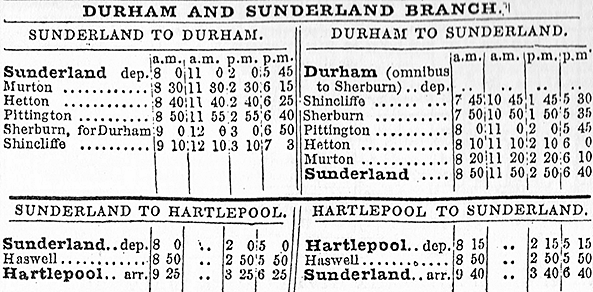
The March 1850 timetable (above) which also includes the Sunderland - Hartlepool service. This was of course still during rope haulage days, or at least to and from Haswell to and from north thereof. There is no suggestion that Sunderland - Hartlepool passengers had to change trains at Haswell, leading to a belief that trains used the sharply curved connection seen on the 1856 map of Haswell. There was a similar curve, south to west, at Murton, but the latter would only have been used by coal trains. From the viewpoint of today it may seem incredible that trains could negotiate such sharp curves but it must be remembered that at the time vehicles were small, short wheelbase four-wheeled types which could and did negotiate sharp curves quite satisfactorily. A description of the passenger carriages and coal wagons is given the extract from Whishaw reproduced herewith.
Francis Whishaw in his 1842 work The Railways of Great Britain and Ireland wrote the following about the Durham & Sunderland Railway:
 "The Durham and Sunderland is the longest public railway in the kingdom worked entirely by the fixed-engine system, and exhibits clearly the inefficiency of this plan for passenger-traffic. The difficulty of starting the trains, the numerous detentions on the way, and the great uncertainty of the time that a journey will occupy, added to the jolts experienced by passengers when reaching a bank-head, or when making a false start, — a thing of very frequent occurrence, — all present themselves as serious objections to the stationary system. Much, no doubt, depends upon the signals in use ; and we should consider money well laid out, on a railway worked entirely by ropes, in laying down from station to station either the electro-galvanic, the hydraulic, or the pneumatic telegraph ; by either of these plans the most complete and rapid communication may be held between persons far apart, both by sound and by sight : the cost of a single line of communication is from 200/. a mile upwards. The first Act of Parliament for the construction of this line received the royal assent on the 13th August, 1834, by which the Company were allowed to raise in joint-stock a capital of 102,000/.. By another Act, obtained in July 1837, which received the royal assent on the 3d of that month, the Company were authorised to raise an additional capital in joint-stock of 90,000/., and by loan 64,000/., making the total 256,000/.. "The Durham and Sunderland is the longest public railway in the kingdom worked entirely by the fixed-engine system, and exhibits clearly the inefficiency of this plan for passenger-traffic. The difficulty of starting the trains, the numerous detentions on the way, and the great uncertainty of the time that a journey will occupy, added to the jolts experienced by passengers when reaching a bank-head, or when making a false start, — a thing of very frequent occurrence, — all present themselves as serious objections to the stationary system. Much, no doubt, depends upon the signals in use ; and we should consider money well laid out, on a railway worked entirely by ropes, in laying down from station to station either the electro-galvanic, the hydraulic, or the pneumatic telegraph ; by either of these plans the most complete and rapid communication may be held between persons far apart, both by sound and by sight : the cost of a single line of communication is from 200/. a mile upwards. The first Act of Parliament for the construction of this line received the royal assent on the 13th August, 1834, by which the Company were allowed to raise in joint-stock a capital of 102,000/.. By another Act, obtained in July 1837, which received the royal assent on the 3d of that month, the Company were authorised to raise an additional capital in joint-stock of 90,000/., and by loan 64,000/., making the total 256,000/..
Course of Railway, &c. — Commencing at the station on Sunderland Moor, this line proceeds by Ryhope and Seaton to Merton, at which place the Haswell and Durham branches diverge; the former being in direct communication with the Hartlepool Railway, and the latter continuing on to Sherbum, which is the station for Durham, and to and from which city the passengers are conveyed by a stage-coach.
There are altogether eight planes, varying in inclination from 1 in 60 to 1 in 264. The first, or Ryhope plane, is 5616 yards in length; the second, or Seaton Incline, 4485 yards; and the third, or Merton, 2427 yards. These three planes are all ascending towards Merton junction. The planes descending from thence are, first, that to Appleton, 1227 yards ; next, to Hetton, 1586 yards ; the third, to the road leading to Alexander Pit, 2850 yards ; the fourth, that to Piddington Railway, 1400 yards ; and lastly, the Sherbum plane, 3712 yards in length. Thus the whole length of planes is 23,302 yards, or 13.23 miles.
Earthworks, Bridges, &c. — Some of the embankments on this railway are formed chiefly of small coal, which is, perhaps, the best material that can possibly be used for this purpose; the cost is stated to have been 9d. per cubic yard: except, however, in the largest coal-districts, its use is entirely precluded by the cost of carriage. The width of cuttings is about 28 feet at level of rails. The deepest cutting on the line is at Shincliffe, through loose clay and sand; its length is about 25 chains, and greatest depth 60 feet, the slopes being 1½ to 1. Considerable difficulty is experienced in preventing slips in some of the cuttings, where the material is of soapy clay and loose sand. Wooden troughs are used on the slopes to carry off the water into the side-drains below. In some cases, the foot of the slope is paved; but this alone will never prevent the upper portions of such slopes from slipping. We are fully persuaded, that in laying out a railway, the length had better be considerably increased, if it is possible thereby to avoid any extent of such treacherous material, which incurs a constant annual outlay, and is sometimes the cause of the railway being entirely stopped for hours together.
The bridges over a railway worked by ropes are necessarily not required to have their arches so high as when over a locomotive's line, the height in that case being regulated by the height of the engine's chimney: hence, in a long line there would be a considerable saving in the item of bridges on this account.
Gauge of Way, &c. — The gauge is 4 feet 8½ inches; and where there are two lines of way, the intermediate space is 4 feet 5 inches. In some parts, where the ascending and descending trains do not pass each other, there are three rails only; and at the bank-tops there are four lines of way. The rails are of different kinds; some of cast iron, and of fish-bellied form, 6½ inches deep in middle, 2½ inches wide at top, and the upper web being If inches thick; they are in 4-feet lengths, some weighing 84 lbs. each, and others 68 lbs. There are also wrought-iron single parallel rails on the embankments, weighing 42 lbs. to the yard; these are fixed with 3-feet bearings in joint-chairs, each weighing 14 lbs, and intermediate chairs 10 Ib. This latter description of rail was furnished by Losh, Wilson, and Bell, at 11/. per ton.
There is an entire absence of stone blocks throughout this line; cross sleepers of larch-logs, 7 inches diameter, are used both in cuttings and on embankments ; those to which joint-chairs are secured being 8 feet long, and the others 7 feet: the cost of the former being 3d., and of the latter Is. 9d. each. The ballast is of small coal throughout; the fencing consists chiefly of posts and three rails.
Stationary Engines — To work this railway, there are eight fixed engines : the first, or Sunderland engine, being of seventy-horse power ; the second, or Seaton Bank-top, forty-two horse; the third, or Merton, seventy horse; the fourth, or Appleton, eighty-three horse; the fifth, or Hetton, forty-two horse; the sixth, or Moorsley, fifty-two horse ; the seventh, or Piddington, eighty-five horse; and the eighth, or Sherbum, also of eighty-five horse power. Thus the united power is equal to that of five hundred and twenty-nine horses. The men employed in this department are nine engine-men, at 24s. a week each; twelve stokers, at 18s.; and nine drummers, at 14s. each per week.
The first plane, ascending from Sunderland to Ryhope, is worked by three ropes; two being each 2450 fathoms in length, of 5 inches circumference, and weighing together 43,200 lbs, ; and the third 4½ inches circumference, and weighing 13,216 lbs,, and also 2450 fathoms long.
The Seaton plane is worked by one 7½-inch rope, 2,325 fathoms in length, and weighing 32,588 lbs. ; the rope is drawn out by the wagons descending by gravity.
The Merton Incline has two ropes; the one a 5-inch, 1 250 fathoms in length, and weighing 8333 lbs.; the other of 6} inches circumference, 675 fathoms in lengthy and weighing 6986 lbs.
The fourth plane is worked by one rope for the ascending, and by gravity for the descending wagons: this rope is of 6} inches circumference, 740 fathoms in length, and weighing 8990 lbs.
The fifth incline is also worked by one rope, which is of 4i inches circumference, 1425 fathoms in length, and weighs 7694 lbs.
The sixth plane has two ropes; the one being of the same length and weight as the last; and the other being 700 fathoms in length, 5i inches in circumference, and weighing 5124 lbs.
The seventh and eighth planes are each worked by a single rope; the length of each of which is 2450 fathoms; the size of the seventh being 51 inches, and the weight 21,600 lbs; and of the eighth, 4 inches and the weight 15,120 lbs.
The whole weight of ropes, therefore, is 170,545 lbs., or 76.13 tons.
Mr. Blenkinsopp, the engineer of this railway, estimates the cost of these ropes at 40/. per ton, and their average duration about nine months. In this case, the annual cost for ropes on this line would be 2283.90/., or 172.63/. per mile.
At level road-crossings, the ropes run in channels properly constructed for the purpose.
The rope-sheeves are of cast iron, weighing 28 lbs. each, 12 inches in diameter and 7 inches wide; some of them being fixed in cast-iron standards, and others in wooden boxes, at intervals of 18 and 24 feet respectively. In curved portions of the line they are inclined to the horizon. At night the way is lighted by large fire-lamps, three at each bank-head.
 Carriages. — The carriages for the conveyance of passengers, which were furnished by Mr. Usher, of Newcastle, are of two kinds, mixed and second-class; the mixed having one first-class compartment in the middle which is closed on each side and two second-class compartments open on each side; and the second-class carriages having each three compartments all open at the sides. The fares however, are the same, whether for the open or closed compartments. These carriages have each a narrow iron footboard the whole length on each side. The luggage is carried in lockers under the seats. The passenger-carriages always accompany coal-trains. Carriages. — The carriages for the conveyance of passengers, which were furnished by Mr. Usher, of Newcastle, are of two kinds, mixed and second-class; the mixed having one first-class compartment in the middle which is closed on each side and two second-class compartments open on each side; and the second-class carriages having each three compartments all open at the sides. The fares however, are the same, whether for the open or closed compartments. These carriages have each a narrow iron footboard the whole length on each side. The luggage is carried in lockers under the seats. The passenger-carriages always accompany coal-trains.
In 1838, the number of passengers conveyed on this line amounted to 77,421 and the receipts on account of passengers and parcels to 2024/. 18s. 9d.
Wagons. — The wagons used on this line belong to the coal-owners; they are constructed generally of wooden framing, lined with plate iron. The weight of a wagon is about 30 cwt.; and the cost is stated to be 25/.
The usual train consists of twenty-four wagons laden in one direction, and the same number empty in the other direction. The average speed of the trains is about 8½ miles per hour, when the whole is in good working condition, and the signals properly given. The stoppages average about four minutes each.
There are about twenty men to keep the way in repair, including labourers. The waymen receive 25s., and the labourers 12s. to 18s a-week each. The whole, however, is under a contract at 25/. a-week, or 1300/. per annum. The way-leaves amount to 5000/. a-year, or nearly 378/. per mile.
This railway is altogether under the direction of Mr. Blenkinsopp, who appears to be thoroughly acquainted with the fixed-engine system; and who evidently pays considerable attention to the interests of the Company for which he is engaged".
The above extract from Whishaw is the most comprehensive work covering the Durham & Sunderland known to survive. Some explanation of its wording may however be advantageous as follows. 'King-dom' means 'domain of a King' regardless of whether a King or Queen is on the throne and the use of a hyphen is just an archaic spelling of 'kingdom'. '"Electro-galvanic' means a wet cell or battery, the modern day equivalent being, for example, a lead-acid battery. The symbol 'I' means pound or pounds in terms of currency and derives from the Latin 'libra' or 'librae', thus '256,000l.' would be written today as '£256,000'. In pre decimal Britain pounds, shillings and pence was frequently written as "lsd" and this habit remained until the introduction of decimal currency. A 'fathom' is a length of six feet and is today more usually maritime associated but there is a connection through rope manufacturers who, being involved with maritime ropes, would use the fathom to quote rope lengths. A "drummer", in the winding engine context, was a person in charge of the rope or cable drums. It will be noted that Whishaw spelled Murton as 'Merton' and this was probably just a spelling error. Interesting for the time is the use of the decimal '13.23 miles' although this may have been a much later edit, perhaps due to the original text being damaged or otherwise unreadable.
Whishaw mentions 'At level road-crossings, the ropes run in channels properly constructed for the purpose'. The channels were presumably of cast iron but quite how this worked given the roads of the time, which may have been surfaced with crushed but loose stone, cinders or may have been nothing more than dirt tracks is unclear. Perhaps the roads were laid with setts or cobbles either side of the channels to provide some sort of stability.
Whishaw's list of stationary engines contains some errors or, at best, confusions; for Appleton read Eppleton and for Piddington read Pittington. There was also a Haswell Engine, actually located at Murton and therefore this location had two engines.
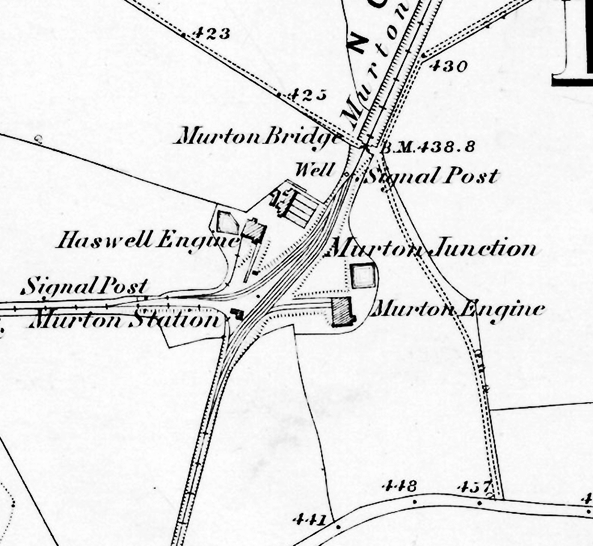
Another extract of the OS 6" map surveyed in 1856, showing both Haswell and Murton Engines. Eppleton Engine was located off the left of the map. The engines were located at the top in the inclines they worked, or Bank Top(s) in Durham parlance. The alignment of the two engines at Murton is telling of the sections they worked. For example Haswell Engine worked the line south of Murton and Murton Engine the section from Eppleton. Note the connecting line with its sharp curve running south to west through what would become Murton goods yard. Note also Murton Station, Murton Junction and Murton Bridge of which the latter two names have at various times been confusingly applied to the station.
 Whishaw concentrated upon the Sunderland to Shincliffe line and made just one brief mention of the Haswell branch, which creates a problem for us today. In 1856 rope working was still the order of the day yet the OS map of that year shows no stationary engines between Sunderland and Haswell with the exception of the Haswell Engine located at Murton. The distance between Murton and Haswell was around 2½ miles and it is unlikely a single engine could have worked a rope of that length (and weight) while hauling a train. Either the rope of the Haswell Engine did not go all the way to Haswell or there was another engine further south, perhaps at Murton Moor, just north of South Hetton. The absence of engines south or north of Murton on the 1856 map suggests the North Eastern Railway, which had been formed by a number of mergers in 1854, abandoned rope haulage on the Sunderland - Haswell section sometime between that year and 1856, leaving the Shincliffe line to trundle on with rope haulage until 1858. Whishaw concentrated upon the Sunderland to Shincliffe line and made just one brief mention of the Haswell branch, which creates a problem for us today. In 1856 rope working was still the order of the day yet the OS map of that year shows no stationary engines between Sunderland and Haswell with the exception of the Haswell Engine located at Murton. The distance between Murton and Haswell was around 2½ miles and it is unlikely a single engine could have worked a rope of that length (and weight) while hauling a train. Either the rope of the Haswell Engine did not go all the way to Haswell or there was another engine further south, perhaps at Murton Moor, just north of South Hetton. The absence of engines south or north of Murton on the 1856 map suggests the North Eastern Railway, which had been formed by a number of mergers in 1854, abandoned rope haulage on the Sunderland - Haswell section sometime between that year and 1856, leaving the Shincliffe line to trundle on with rope haulage until 1858.
What came to be known as the Leamside Line had opened in stages commencing in 1833 while what is now known as the Durham Coast Line opened in stages from 1838. While these lines served, mainly but not entirely, different intermediate points to the Durham & Sunderland in terms of the latter's Sunderland - Haswell route and beyond, it did leave the Durham & Sunderland as the central of three south - north routes competing with each other in respect of through traffic. The area was littered with collieries, wagonways (often spelled 'waggonway(s)') and railways owned by the colliery companies. The Durham & Sunderland was therefore very purposeful in handling the once incessant flow of coal trains which otherwise would had hindered capacity on the other routes and perhaps to the detriment of passenger services.
 What became the Durham Elvet branch had a chequered history. The Elvet terminus was never successful and both it and the line back to Pittington (exclusive) closed to regular passenger services on 1 January 1931 and to goods on 11 January 1954. However the annual Durham Miners Gala trains continued to use the line until 18 July 1953, the war years excepted. There were several of these Gala trains originating at various locations in County Durham. In 1953 a circus train reputedly arrived at Durham Elvet which is often claimed to have been the final passenger train to use Elvet station although whether a circus train could be classed as a passenger train is open to question, but some passengers related to the circus would have been onboard. Some sources, however, doubt the accuracy of the final passenger train claim. Sources also vary between 'final' passenger train and 'among the last passenger trains' while the date is never expanded beyond simply '1953'. A number of videos are available online which claim to show "the last train" on various lines around the country when in fact the trains recorded were not the last trains at all and at best were recorded during the final day or final week. Bearing this in mind the claim about the Elvet circus train should be treated with caution. While there is almost no doubt it ran, the question is when. What became the Durham Elvet branch had a chequered history. The Elvet terminus was never successful and both it and the line back to Pittington (exclusive) closed to regular passenger services on 1 January 1931 and to goods on 11 January 1954. However the annual Durham Miners Gala trains continued to use the line until 18 July 1953, the war years excepted. There were several of these Gala trains originating at various locations in County Durham. In 1953 a circus train reputedly arrived at Durham Elvet which is often claimed to have been the final passenger train to use Elvet station although whether a circus train could be classed as a passenger train is open to question, but some passengers related to the circus would have been onboard. Some sources, however, doubt the accuracy of the final passenger train claim. Sources also vary between 'final' passenger train and 'among the last passenger trains' while the date is never expanded beyond simply '1953'. A number of videos are available online which claim to show "the last train" on various lines around the country when in fact the trains recorded were not the last trains at all and at best were recorded during the final day or final week. Bearing this in mind the claim about the Elvet circus train should be treated with caution. While there is almost no doubt it ran, the question is when.
After closure to passengers of the Pittington - Elvet section a passenger service continued to operate Sunderland - Murton - Pittington until 5 January 1953. See the 1939 LNER timetable below.
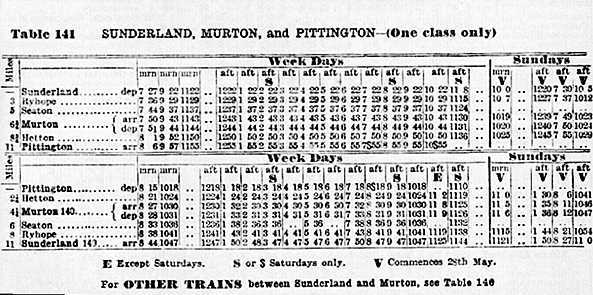
The service was surprisingly frequent and there was a basic Sunday service during late spring and summer between Sunderland and Hetton but, like certain weekday trains, these did not call at Seaton (sometimes referred to as Seaton Bank Top). The service would have provided for the miners and their families at Hetton but why trains ran to and from Pittington is something of a puzzle as Pittington station was quite remote and the locality sparsely populated at that time. The North East was something of a stronghold of the LNER's Sentinel steam railcars, also the ungainly and rather troublesome Clayton railcars, which latter had been withdrawn by 1939. The Sentinel railcars are known to have operated the Sunderland - Pittington service and this likely explains the "(One class only)". When the Sentinels were gradually taken out of traffic the service was usually operated by a Class G5 0-4-4T with 3-car coaching stock sets.
Below is the timetable from the same period for the Sunderland - West Hartlepool service.
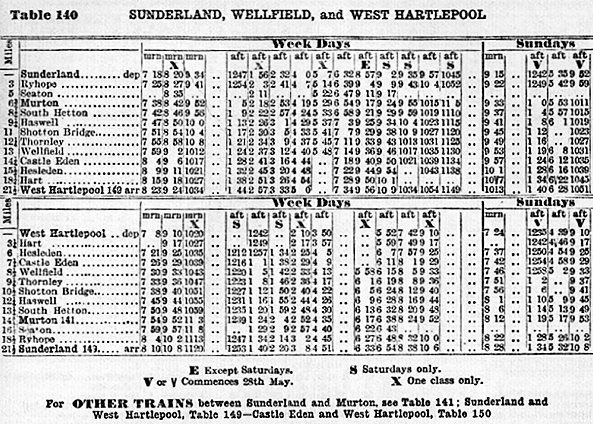
As with the Pittington timetable, the service was quite frequent but with a gap late morning. Not all trains ran through and, again, not all called at Seaton. With the Pittington trains, Murton therefore had an excellent service and in particular to Sunderland. It must be remembered that the world of 1939 was a very different to that of today and notwithstanding Herr Hitler. At the time the area was littered with collieries and the coast of County Durham, which then included Sunderland along with what is now Teesside, was a hive of activity with ports, shipyards and other heavy industries. Some of these industries remain today but to a much lesser degree. These industries worked around the clock and workers and their families needed to travel, although many lived almost literally on the doorstep of their employment. After the Second World War the decline began to set in and, for once, the increasing use of road transport cannot be blamed.
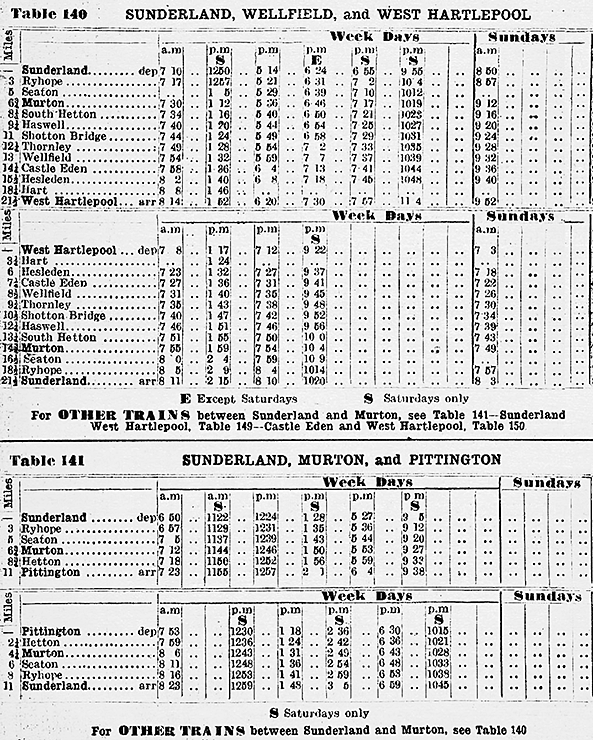
The above timetable is from Bradshaw, 1 January 1948. The timetables were still headed according to the 'Big Four' companies, in this case L.N.E.R. but cropped from the scan, but this was in fact the first timetable book issued for what had become on the same day British Railways. In comparison with the 1939 timetable reproduced earlier it will be seen the services had been greatly reduced, with many being Saturdays Only. There was no Sunday service to Pittington during the winter months. The service reduction was probably enacted during the Second World War.
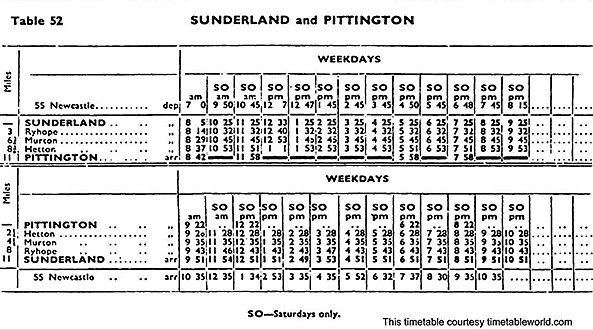
The above timetable was issued by British Railways North Eastern Region in September 1952 and was the final timetable covering the Sunderland - Pittington passenger service, the service south of Murton having already been withdrawn (see below). While the service frequency was reasonable in comparison with 1948 it had by this time been reduced to Saturdays Only and with only a few trains continuing beyond Hetton to Pittington. Probably the Saturday service was to allow people, mainly of Hetton, to go shopping and perhaps to a cinema in Sunderland. The omission, compared to 1948, of the Sunday columns suggests the summer-only Sunday service had been withdrawn altogether by this time.
The Sunderland - West Hartlepool service was withdrawn on and from 9 June 1952 with most intermediate stations on the Sunderland - Haswell section closing to passengers at the same time, the exceptions being Ryhope and Murton. Murton station was to close to passengers on and from 5 January 1953 with the withdrawal of the Pittington service. From the 1953 date the section of the Elvet branch between Hetton and Murton was used for wagon storage. Hetton Colliery, deep in Lambton Railway territory was served via a connection with the Leamside Line, itself now abandoned. Hetton - Murton was finally abandoned in 1963 and the track lifted during 1964.
 The railways are particularly good at moving heavy bulk loads and coal was the main such commodity which kept several railways operational long after regular passenger traffic ceased. This was the case with the north - south line through Murton between Ryhope and South Hetton. Murton Colliery was not rail connected at or anywhere near Murton station. Instead the Durham & Sunderland line connected with what was the South Hetton Railway at South Hetton, this line becoming part of the National Coal Board and finally British Coal system. This was the line which served Seaham Harbour with its once famous internal railway system. Murton Colliery became part of Hawthorn Combined Mine and was connected to the aforementioned Seaham Harbour line roughly midway between South Hetton and Seaham, at which latter location there was also a siding connection with the Durham Coast Line. At one time coal traffic was exchanged between the coal board and the main line at South Hetton but latterly BR ran right through to Hawthorn Combined Mine. Following the end of steam, English Electric Type 3, later Class 37, diesel locomotives were used. These locomotives were, initially at least, from the early 'split headcode' batch which had been divided between the North East and East Anglia when new. In later years the Sunderland (South Dock) to Hawthorn coal trains were largely in the hands of Class 56 diesel locomotives. Coal trains also departed southwards via Shotton Bridge and Wellfield. The railways are particularly good at moving heavy bulk loads and coal was the main such commodity which kept several railways operational long after regular passenger traffic ceased. This was the case with the north - south line through Murton between Ryhope and South Hetton. Murton Colliery was not rail connected at or anywhere near Murton station. Instead the Durham & Sunderland line connected with what was the South Hetton Railway at South Hetton, this line becoming part of the National Coal Board and finally British Coal system. This was the line which served Seaham Harbour with its once famous internal railway system. Murton Colliery became part of Hawthorn Combined Mine and was connected to the aforementioned Seaham Harbour line roughly midway between South Hetton and Seaham, at which latter location there was also a siding connection with the Durham Coast Line. At one time coal traffic was exchanged between the coal board and the main line at South Hetton but latterly BR ran right through to Hawthorn Combined Mine. Following the end of steam, English Electric Type 3, later Class 37, diesel locomotives were used. These locomotives were, initially at least, from the early 'split headcode' batch which had been divided between the North East and East Anglia when new. In later years the Sunderland (South Dock) to Hawthorn coal trains were largely in the hands of Class 56 diesel locomotives. Coal trains also departed southwards via Shotton Bridge and Wellfield.
Meanwhile following closure to passengers of Murton, which remained open for goods traffic until 13 June 1960, the station was dismantled in a somewhat piecemeal fashion with what remained becoming increasingly derelict until by the 1980s just a brick hut remained at the site of what had been the southbound platform. The stationmaster's house survived, however, and still stands today. The remaining signal boxes were abolished by 1984 and the line singled in two stages, Ryhope to Murton and Murton to South Hetton with the level crossing being automated. All this was indicative of the rundown in coal traffic. Hawthorn Combined Mine, set up as a consolidation on 2 January 1960, embraced Murton, Elemore, Eppleton and Hawthorn Coke Works. Elemore closed in February 1974, Eppleton in March 1986 and the coke works sometime in 1985. In addition, South Hetton Colliery, which dated from 1833, had closed in July 1982. What remained operationally of Hawthorn Combined Mine by 1991 ceased operation in November 1991 with the official closure date being, apparently, sometime in 1992. This was not however the end of the Durham & Sunderland line as stockpiles of coal continued to be removed to Sunderland intermittently as demand dictated, most of the output being exported. This operation continued until late 1992 if not into early 1993. Track lifting on what by then was a single line began immediately following the end of this stockpile removal traffic and what by then had become a former railway was converted into a footpath and cycleway.
Route map drawn by Alan Young. Tickets from Michael Stewart
SOURCES:
To see other stations on the Durham & Sunderland Railway
click on the station name:
Durham Elvet, Sherburn House, Pittington & Hetton
See also Ryhope 1st site & Ryhope 2nd site |

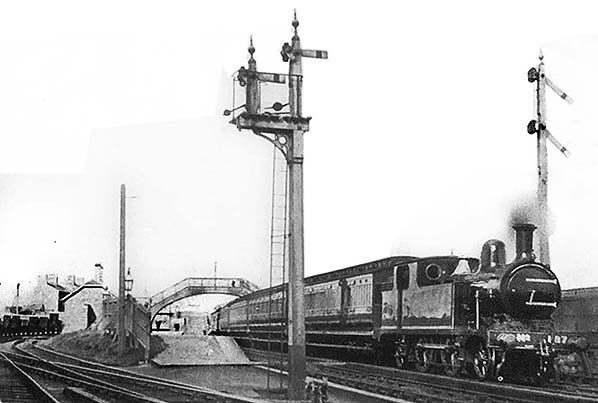

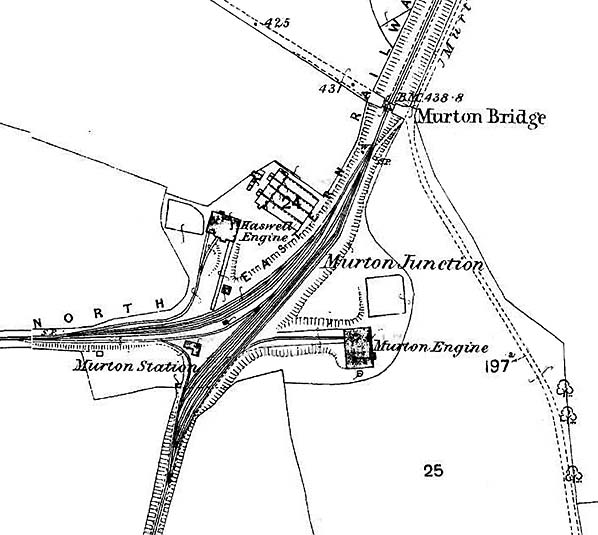
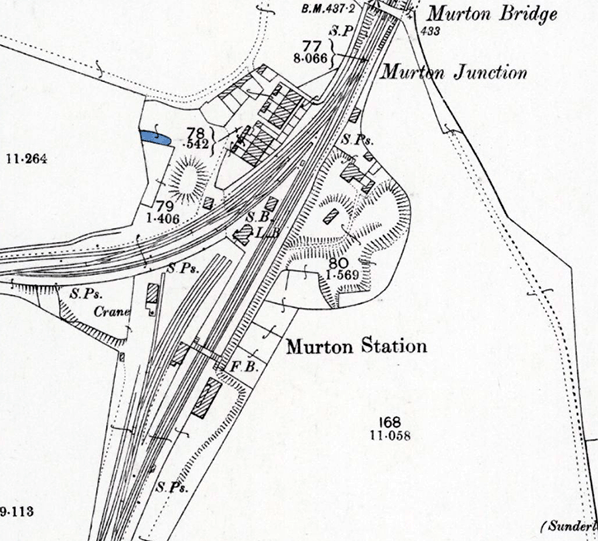
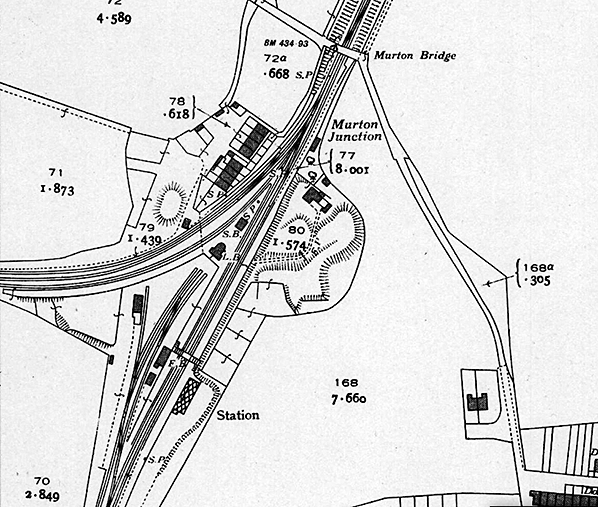
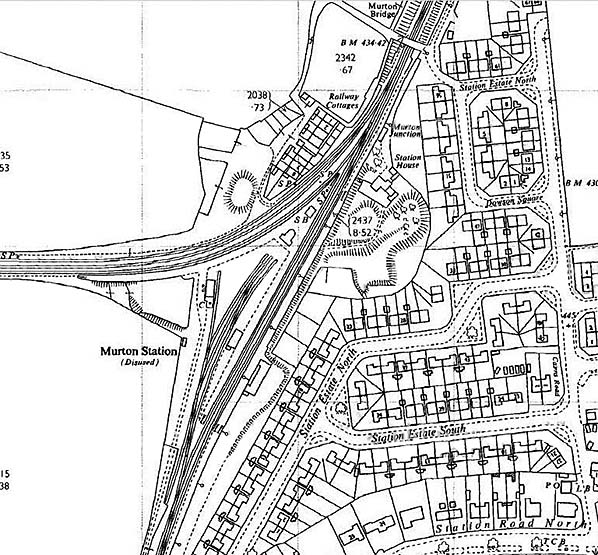
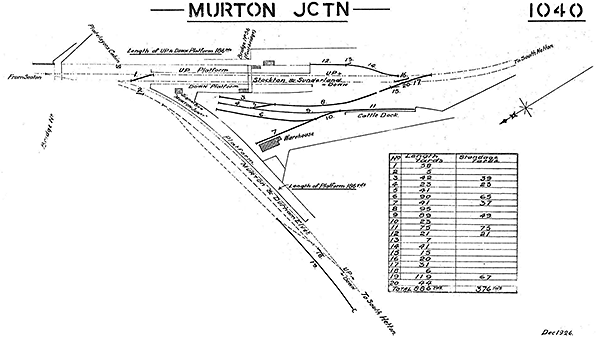
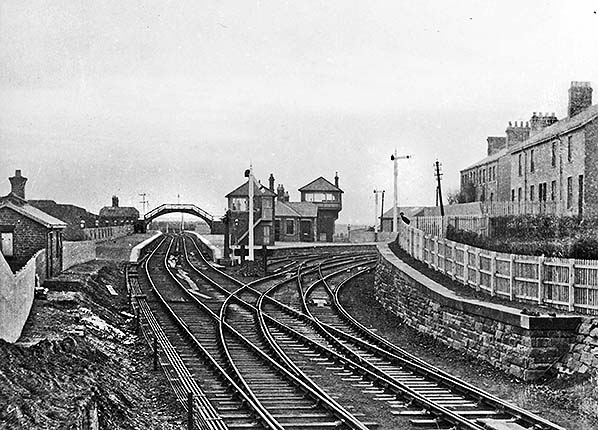
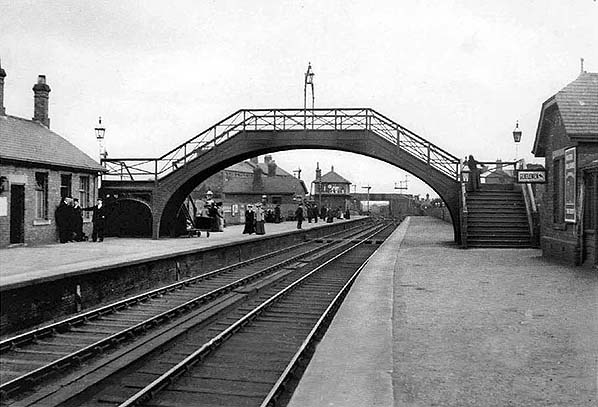
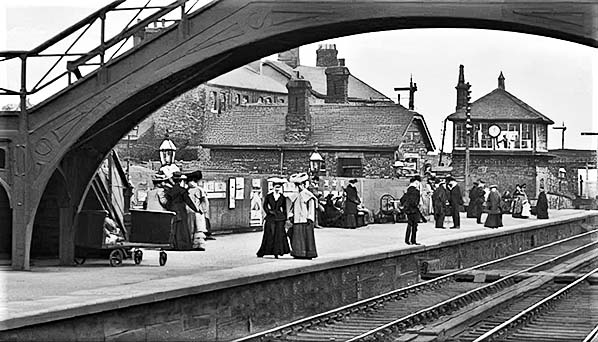
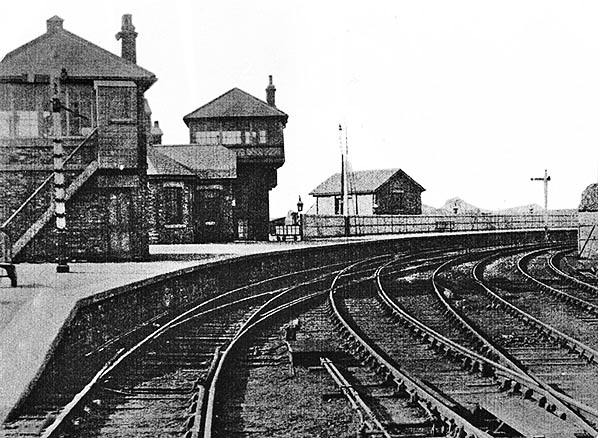
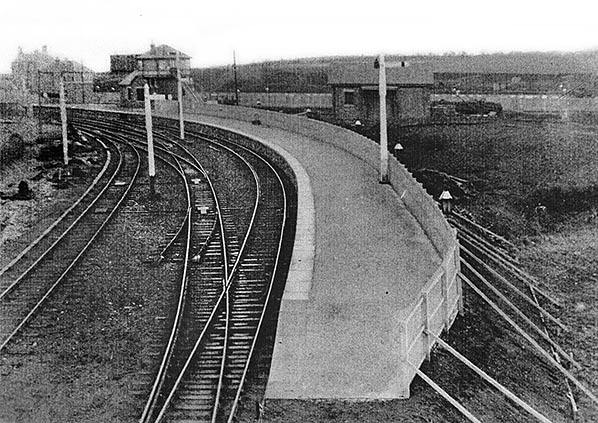 A view facing roughly east across the Durham Elvet branch platform. The branch had existed long before this photograph was taken so one has to question what appears to be a brand new platform. Either the entire platform was a new replacement or it was a lengthy extension of an earlier platform. Note the shored-up fencing and proliferation of wooden slotted-post signals. In the left background both signal boxes are present, providing us with a date window of 1893 to circa 1914. The leftmost track was a siding which ended just beyond the station limit, behind the camera. The centre track, which is connected to the siding, was a loop avoiding the platform. Its purpose is unclear although it may have been a refuge to get coal trains out of the way of passenger trains, otherwise coal trains would have to have been held on the main line as the branch was single track.
A view facing roughly east across the Durham Elvet branch platform. The branch had existed long before this photograph was taken so one has to question what appears to be a brand new platform. Either the entire platform was a new replacement or it was a lengthy extension of an earlier platform. Note the shored-up fencing and proliferation of wooden slotted-post signals. In the left background both signal boxes are present, providing us with a date window of 1893 to circa 1914. The leftmost track was a siding which ended just beyond the station limit, behind the camera. The centre track, which is connected to the siding, was a loop avoiding the platform. Its purpose is unclear although it may have been a refuge to get coal trains out of the way of passenger trains, otherwise coal trains would have to have been held on the main line as the branch was single track.old2.jpg) This photograph dates from sometime between 1893 and circa 1914 and is especially interesting as it shows the water crane, which was to a classic North Eastern Railway design, and which existed briefly at the location seen. There was a dock or loco siding, the actually purpose being unclear, which existed equally briefly on the right. There is also some evidence of the platforms being lengthened at this, south, end of the station but the sequence of these features remains uncertain. The clipped gable buildings appear, insofar as this line was concerned, to have been peculiar to Murton. Note the propping of the fence behind the platform, left of centre. These props could be found in several locations at Murton and while they could have been connected with platform extensions some remained, albeit no doubt renewed over the years, in situ to the end of the station's existence. The area around Murton station had its share of abandoned mine and quarry workings, suggesting subsidence or slippage may have been an issue. Ahead of the camera, the finial of the signal post is for some reason sitting on the ground. The small goods yard is seen to the left but the cattle dock is out of view behind and left of the camera. A reversal from within the goods years was necessary to reach the cattle dock, a quite common situation around the country. The signal behind the goods wagons, which at first glance may appear to be in an odd location, was on the Durham Elvet line which curved quite sharply westwards.
This photograph dates from sometime between 1893 and circa 1914 and is especially interesting as it shows the water crane, which was to a classic North Eastern Railway design, and which existed briefly at the location seen. There was a dock or loco siding, the actually purpose being unclear, which existed equally briefly on the right. There is also some evidence of the platforms being lengthened at this, south, end of the station but the sequence of these features remains uncertain. The clipped gable buildings appear, insofar as this line was concerned, to have been peculiar to Murton. Note the propping of the fence behind the platform, left of centre. These props could be found in several locations at Murton and while they could have been connected with platform extensions some remained, albeit no doubt renewed over the years, in situ to the end of the station's existence. The area around Murton station had its share of abandoned mine and quarry workings, suggesting subsidence or slippage may have been an issue. Ahead of the camera, the finial of the signal post is for some reason sitting on the ground. The small goods yard is seen to the left but the cattle dock is out of view behind and left of the camera. A reversal from within the goods years was necessary to reach the cattle dock, a quite common situation around the country. The signal behind the goods wagons, which at first glance may appear to be in an odd location, was on the Durham Elvet line which curved quite sharply westwards.
 In 1846 the Durham & Sunderland Railway was purchased by the Newcastle & Darlington Junction railway who obtained an Act for line from north of Sherburn to Shincliffe and on to Bishop Auckland. There was to be a triangular junction for access to Durham Elvet station but the line was never built. In 1846 the N & DJR was renamed the York & Newcastle Railway and the following year it amalgamated with the York, Newcastle & Berwick Railway which itself merged with other lines to form the North Eastern Railway in 1854. In 1893 the North Eastern Railway opened a station in Elvet in Durham city. This was served by a new line branching off the old Shincliffe line at Sherburn. From the 24th July 1893 the service to Shincliffe was withdrawn and the station closed. At the same time Sherburn House Station was re-sited from the junction onto the new branch. Although Shincliffe was, until Durham Elvet was built, supposedly the station for Durham, contemporary timetables name Sherburn as the station for Durham with a connecting omnibus service. Sherburn station can be a source of confusion; the 1837 station was named simply "Sherburn" and was renamed to "Sherburn House" in 1874 with this name transferring to the second, 1893, station.
In 1846 the Durham & Sunderland Railway was purchased by the Newcastle & Darlington Junction railway who obtained an Act for line from north of Sherburn to Shincliffe and on to Bishop Auckland. There was to be a triangular junction for access to Durham Elvet station but the line was never built. In 1846 the N & DJR was renamed the York & Newcastle Railway and the following year it amalgamated with the York, Newcastle & Berwick Railway which itself merged with other lines to form the North Eastern Railway in 1854. In 1893 the North Eastern Railway opened a station in Elvet in Durham city. This was served by a new line branching off the old Shincliffe line at Sherburn. From the 24th July 1893 the service to Shincliffe was withdrawn and the station closed. At the same time Sherburn House Station was re-sited from the junction onto the new branch. Although Shincliffe was, until Durham Elvet was built, supposedly the station for Durham, contemporary timetables name Sherburn as the station for Durham with a connecting omnibus service. Sherburn station can be a source of confusion; the 1837 station was named simply "Sherburn" and was renamed to "Sherburn House" in 1874 with this name transferring to the second, 1893, station.

 "The Durham and Sunderland is the longest public railway in the kingdom worked entirely by the fixed-engine system, and exhibits clearly the inefficiency of this plan for passenger-traffic. The difficulty of starting the trains, the numerous detentions on the way, and the great uncertainty of the time that a journey will occupy, added to the jolts experienced by passengers when reaching a bank-head, or when making a false start, — a thing of very frequent occurrence, — all present themselves as serious objections to the stationary system. Much, no doubt, depends upon the signals in use ; and we should consider money well laid out, on a railway worked entirely by ropes, in laying down from station to station either the electro-galvanic, the hydraulic, or the pneumatic telegraph ; by either of these plans the most complete and rapid communication may be held between persons far apart, both by sound and by sight : the cost of a single line of communication is from 200/. a mile upwards. The first Act of Parliament for the construction of this line received the royal assent on the 13th August, 1834, by which the Company were allowed to raise in joint-stock a capital of 102,000/.. By another Act, obtained in July 1837, which received the royal assent on the 3d of that month, the Company were authorised to raise an additional capital in joint-stock of 90,000/., and by loan 64,000/., making the total 256,000/..
"The Durham and Sunderland is the longest public railway in the kingdom worked entirely by the fixed-engine system, and exhibits clearly the inefficiency of this plan for passenger-traffic. The difficulty of starting the trains, the numerous detentions on the way, and the great uncertainty of the time that a journey will occupy, added to the jolts experienced by passengers when reaching a bank-head, or when making a false start, — a thing of very frequent occurrence, — all present themselves as serious objections to the stationary system. Much, no doubt, depends upon the signals in use ; and we should consider money well laid out, on a railway worked entirely by ropes, in laying down from station to station either the electro-galvanic, the hydraulic, or the pneumatic telegraph ; by either of these plans the most complete and rapid communication may be held between persons far apart, both by sound and by sight : the cost of a single line of communication is from 200/. a mile upwards. The first Act of Parliament for the construction of this line received the royal assent on the 13th August, 1834, by which the Company were allowed to raise in joint-stock a capital of 102,000/.. By another Act, obtained in July 1837, which received the royal assent on the 3d of that month, the Company were authorised to raise an additional capital in joint-stock of 90,000/., and by loan 64,000/., making the total 256,000/.. Carriages. — The carriages for the conveyance of passengers, which were furnished by Mr. Usher, of Newcastle, are of two kinds, mixed and second-class; the mixed having one first-class compartment in the middle which is closed on each side and two second-class compartments open on each side; and the second-class carriages having each three compartments all open at the sides. The fares however, are the same, whether for the open or closed compartments. These carriages have each a narrow iron footboard the whole length on each side. The luggage is carried in lockers under the seats. The passenger-carriages always accompany coal-trains.
Carriages. — The carriages for the conveyance of passengers, which were furnished by Mr. Usher, of Newcastle, are of two kinds, mixed and second-class; the mixed having one first-class compartment in the middle which is closed on each side and two second-class compartments open on each side; and the second-class carriages having each three compartments all open at the sides. The fares however, are the same, whether for the open or closed compartments. These carriages have each a narrow iron footboard the whole length on each side. The luggage is carried in lockers under the seats. The passenger-carriages always accompany coal-trains.
 Whishaw concentrated upon the Sunderland to Shincliffe line and made just one brief mention of the Haswell branch, which creates a problem for us today. In 1856 rope working was still the order of the day yet the OS map of that year shows no stationary engines between Sunderland and Haswell with the exception of the Haswell Engine located at Murton. The distance between Murton and Haswell was around 2½ miles and it is unlikely a single engine could have worked a rope of that length (and weight) while hauling a train. Either the rope of the Haswell Engine did not go all the way to Haswell or there was another engine further south, perhaps at Murton Moor, just north of South Hetton. The absence of engines south or north of Murton on the 1856 map suggests the North Eastern Railway, which had been formed by a number of mergers in 1854, abandoned rope haulage on the Sunderland - Haswell section sometime between that year and 1856, leaving the Shincliffe line to trundle on with rope haulage until 1858.
Whishaw concentrated upon the Sunderland to Shincliffe line and made just one brief mention of the Haswell branch, which creates a problem for us today. In 1856 rope working was still the order of the day yet the OS map of that year shows no stationary engines between Sunderland and Haswell with the exception of the Haswell Engine located at Murton. The distance between Murton and Haswell was around 2½ miles and it is unlikely a single engine could have worked a rope of that length (and weight) while hauling a train. Either the rope of the Haswell Engine did not go all the way to Haswell or there was another engine further south, perhaps at Murton Moor, just north of South Hetton. The absence of engines south or north of Murton on the 1856 map suggests the North Eastern Railway, which had been formed by a number of mergers in 1854, abandoned rope haulage on the Sunderland - Haswell section sometime between that year and 1856, leaving the Shincliffe line to trundle on with rope haulage until 1858. What became the Durham Elvet branch had a chequered history. The Elvet terminus was never successful and both it and the line back to Pittington (exclusive) closed to regular passenger services on 1 January 1931 and to goods on 11 January 1954. However the annual Durham Miners Gala trains continued to use the line until 18 July 1953, the war years excepted. There were several of these Gala trains originating at various locations in County Durham. In 1953 a circus train reputedly arrived at Durham Elvet which is often claimed to have been the final passenger train to use Elvet station although whether a circus train could be classed as a passenger train is open to question, but some passengers related to the circus would have been onboard. Some sources, however, doubt the accuracy of the final passenger train claim. Sources also vary between 'final' passenger train and 'among the last passenger trains' while the date is never expanded beyond simply '1953'. A number of videos are available online which claim to show "the last train" on various lines around the country when in fact the trains recorded were not the last trains at all and at best were recorded during the final day or final week. Bearing this in mind the claim about the Elvet circus train should be treated with caution. While there is almost no doubt it ran, the question is when.
What became the Durham Elvet branch had a chequered history. The Elvet terminus was never successful and both it and the line back to Pittington (exclusive) closed to regular passenger services on 1 January 1931 and to goods on 11 January 1954. However the annual Durham Miners Gala trains continued to use the line until 18 July 1953, the war years excepted. There were several of these Gala trains originating at various locations in County Durham. In 1953 a circus train reputedly arrived at Durham Elvet which is often claimed to have been the final passenger train to use Elvet station although whether a circus train could be classed as a passenger train is open to question, but some passengers related to the circus would have been onboard. Some sources, however, doubt the accuracy of the final passenger train claim. Sources also vary between 'final' passenger train and 'among the last passenger trains' while the date is never expanded beyond simply '1953'. A number of videos are available online which claim to show "the last train" on various lines around the country when in fact the trains recorded were not the last trains at all and at best were recorded during the final day or final week. Bearing this in mind the claim about the Elvet circus train should be treated with caution. While there is almost no doubt it ran, the question is when.



 The railways are particularly good at moving heavy bulk loads and coal was the main such commodity which kept several railways operational long after regular passenger traffic ceased. This was the case with the north - south line through Murton between Ryhope and South Hetton. Murton Colliery was not rail connected at or anywhere near Murton station. Instead the Durham & Sunderland line connected with what was the South Hetton Railway at South Hetton, this line becoming part of the National Coal Board and finally British Coal system. This was the line which served Seaham Harbour with its once famous internal railway system. Murton Colliery became part of Hawthorn Combined Mine and was connected to the aforementioned Seaham Harbour line roughly midway between South Hetton and Seaham, at which latter location there was also a siding connection with the Durham Coast Line. At one time coal traffic was exchanged between the coal board and the main line at South Hetton but latterly BR ran right through to Hawthorn Combined Mine. Following the end of steam, English Electric Type 3, later Class 37, diesel locomotives were used. These locomotives were, initially at least, from the early 'split headcode' batch which had been divided between the North East and East Anglia when new. In later years the Sunderland (South Dock) to Hawthorn coal trains were largely in the hands of Class 56 diesel locomotives. Coal trains also departed southwards via Shotton Bridge and Wellfield.
The railways are particularly good at moving heavy bulk loads and coal was the main such commodity which kept several railways operational long after regular passenger traffic ceased. This was the case with the north - south line through Murton between Ryhope and South Hetton. Murton Colliery was not rail connected at or anywhere near Murton station. Instead the Durham & Sunderland line connected with what was the South Hetton Railway at South Hetton, this line becoming part of the National Coal Board and finally British Coal system. This was the line which served Seaham Harbour with its once famous internal railway system. Murton Colliery became part of Hawthorn Combined Mine and was connected to the aforementioned Seaham Harbour line roughly midway between South Hetton and Seaham, at which latter location there was also a siding connection with the Durham Coast Line. At one time coal traffic was exchanged between the coal board and the main line at South Hetton but latterly BR ran right through to Hawthorn Combined Mine. Following the end of steam, English Electric Type 3, later Class 37, diesel locomotives were used. These locomotives were, initially at least, from the early 'split headcode' batch which had been divided between the North East and East Anglia when new. In later years the Sunderland (South Dock) to Hawthorn coal trains were largely in the hands of Class 56 diesel locomotives. Coal trains also departed southwards via Shotton Bridge and Wellfield.
 Home Page
Home Page